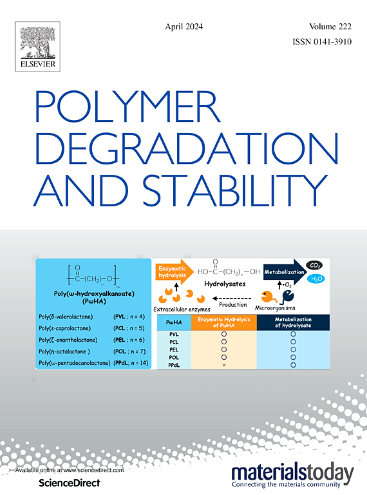Analysis of Poly(ethylene glycol) from the conservation of 17th century shipwreck Vasa and associated wooden objects
IF 6.3
2区 化学
Q1 POLYMER SCIENCE
引用次数: 0
Abstract
Vasa, a Swedish warship that sunk in 1628 and was excavated in 1961, and associated wooden objects underwent a preservation process using various low molecular weights (600, 1500, and 4000 Mn) of poly(ethylene glycol) (PEG) to gradually displace the water within the wooden structure, preventing the collapse of the waterlogged wood upon drying. However, after six decades of aging after application, to what extent are these polymers degraded? To investigate this, a Soxhlet apparatus was used to extract PEG from wooden samples of Vasa, and lyophilization was used to dry aqueous PEG solutions, these samples being the runoff accumulated during the application of different molecular weights of PEG to Vasa and other associated wooden objects. These samples underwent analysis via matrix-assisted laser desorption/ionization – time-of-flight mass spectrometry (MALDI-TOF MS), gel permeation chromatography (GPC), and 1H and 13C nuclear magnetic resonance (NMR) spectroscopy.
The primary discovery was that the PEG within Vasa exhibited minimal degradation, with the dominant identified species, as determined by MALDI-TOF MS and NMR spectroscopy, being HO-PEG-OH. However, small quantities of HO-PEG-OH had undergone degradation, resulting in the formation of PEG chains with distinct end groups, notably a range of carbonyl-based compounds, including aldehydes, carboxylic acids, and esters, as observed through MALDI-TOF MS, 1H, and 13C NMR spectroscopy. These mass spectrometry product peaks could be confirmed by the expected mass difference through various end-group functionalizations, such as oxidations, esterifications, or ether formations. In addition to the carbonyl-based degradation products, some PEG chains had completely cleaved into two separate lower molecular weight HO-PEG-OH polymers, each approximately half of their original molecular weight, as revealed by GPC analysis.
17世纪沉船“瓦萨”号及相关木制品中聚乙二醇的分析
1628年沉没、1961年出土的瑞典战舰瓦萨号(Vasa)和相关的木制品使用各种低分子量(600、1500和4000 Mn)聚乙二醇(PEG)进行保存,以逐渐取代木结构内的水,防止浸水木材在干燥时坍塌。然而,经过60年的老化后,这些聚合物降解到什么程度?为了研究这一点,我们使用索氏装置从Vasa的木制样品中提取PEG,并使用冻干方法干燥PEG水溶液,这些样品是不同分子量的PEG在Vasa和其他相关木制物体上应用期间积累的径流。这些样品通过基质辅助激光解吸/电离飞行时间质谱(MALDI-TOF MS)、凝胶渗透色谱(GPC)和1H和13C核磁共振(NMR)谱分析。主要发现是Vasa中的PEG表现出最小的降解,通过MALDI-TOF MS和NMR波谱确定的优势鉴定物种是HO-PEG-OH。然而,少量的HO-PEG-OH经过降解,形成具有不同端基的PEG链,特别是通过MALDI-TOF MS, 1H和13C NMR光谱观察到的一系列羰基化合物,包括醛类,羧酸类和酯类。这些质谱产物峰可以通过各种端基功能化(如氧化、酯化或醚形成)的预期质量差来确认。GPC分析显示,除了羰基降解产物外,一些PEG链已经完全分裂成两个独立的低分子量HO-PEG-OH聚合物,每个聚合物的分子量约为原始分子量的一半。
本文章由计算机程序翻译,如有差异,请以英文原文为准。
求助全文
约1分钟内获得全文
求助全文
来源期刊

Polymer Degradation and Stability
化学-高分子科学
CiteScore
10.10
自引率
10.20%
发文量
325
审稿时长
23 days
期刊介绍:
Polymer Degradation and Stability deals with the degradation reactions and their control which are a major preoccupation of practitioners of the many and diverse aspects of modern polymer technology.
Deteriorative reactions occur during processing, when polymers are subjected to heat, oxygen and mechanical stress, and during the useful life of the materials when oxygen and sunlight are the most important degradative agencies. In more specialised applications, degradation may be induced by high energy radiation, ozone, atmospheric pollutants, mechanical stress, biological action, hydrolysis and many other influences. The mechanisms of these reactions and stabilisation processes must be understood if the technology and application of polymers are to continue to advance. The reporting of investigations of this kind is therefore a major function of this journal.
However there are also new developments in polymer technology in which degradation processes find positive applications. For example, photodegradable plastics are now available, the recycling of polymeric products will become increasingly important, degradation and combustion studies are involved in the definition of the fire hazards which are associated with polymeric materials and the microelectronics industry is vitally dependent upon polymer degradation in the manufacture of its circuitry. Polymer properties may also be improved by processes like curing and grafting, the chemistry of which can be closely related to that which causes physical deterioration in other circumstances.
 求助内容:
求助内容: 应助结果提醒方式:
应助结果提醒方式:


